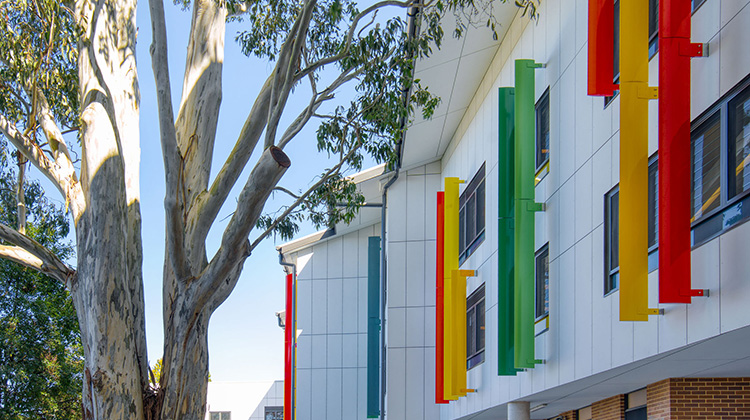Designing for Student Health and Well Being

Maintaining positive health and mental wellbeing in students is one of the key areas of concerns in schools. Research shows that children are bearing the brunt of mental health concerns triggered or exacerbated by the pandemic and the number presenting with mental health or emotional problems. Schools must find ways to stimulate positive environments for students across mental well-being, health, and safety.
The Effect of Environmental Air Quality
According to the EPA, not only does Indoor Air Quality (IAQ) impact the health and academic performance of students but it’s even more impactful for children because their bodies and brains are not fully developed. Exposure to CO2, which is a key factor when measuring the quality of an environment, can result in drowsiness, eye irritation, and inability to concentrate. When poor ventilation provides inadequate fresh-air intake, levels of CO2 in the classroom can rise dramatically.
In 2013 a study found that more than half of the classrooms in New South Wales did not meet State ventilation standards, and that stale air was making students give slower and fewer correct answers in cognitive tests.
Energy Efficiency Is Needed to Improve Air Quality
Maintaining healthy carbon dioxide levels requires bringing in fresh outside air and mixing it with inside air to dilute the rising CO2. Just like adding cold water to a bath that’s too hot. In climates such as or with extremes in temperature, that dilution comes with a cost. We must either heat up or cool down the outside air as it enters the classroom. Schools in Australia combatted over heating in classrooms by installing air-conditioning, but often without correctly calculating the requirements of fresh air intake for children, or the ongoing cost and environmental impact of the system.
Did you know 75% of the energy used by air-conditioners goes into running them? For every KW of energy, you put into the unit only puts out 0.25KW. Imagine leaving the lid open on your Esky. Unfortunately, this is how many school buildings are built and operate, wasting valuable natural resources and effectively throwing money down the drain. A building designed to be air-conditioned should be well sealed and well insulated ensuring the amount of energy (and money) required to cool them is kept to a minimum.
St Ives Sporting Complex
St Ives Sporting Complex is a building that has been designed for both maximum efficiency and maximum performance. It is insulated, sealed, and mechanically ventilated with a constant supply of fresh filtered air.
Using Passive House Design Principles of “fabric first” and fresh air filtration, topped with air-con only, when necessary, JDH’s design achieved a reduction in upfront costs, reduced mechanical plant, and a whopping 30% reduction running costs compared to the almost identical, traditionally constructed building shown in this image adjacent to the right. 0% reduction
Air Quality and Cognitive Function
Teachers will testify to the data which identifies a strong the link between reduced cognitive function and CO2 concentration in the air. How many students tune out when classrooms are hot and stuffy?
Studies show that in any space raising CO2 levels from 550 ppm to 945 ppm reduces the cognitive function of the occupants by 15%. It has been discovered that classrooms often have CO2 levels more than 1400ppm, particularly in Autumn and Winter when we close our windows and ventilation slows down. Scientific studies calculate that CO2 levels at 1,400 ppm reduced cognitive function by an alarming 50%. So, paying attention to the quality of air, and reducing stale air in classrooms is fundamental to providing student environments that support rather than hinder learning.
Mental Health and Wellbeing and Biophilia
What is Biophilic Design?
School environments can support wellbeing in students and teachers through the lens of Biophilic Design. Integrating nature into the design of schools ensures the occupants experience a relationship with nature in their everyday environments that positively contributes to psychological wellbeing.
In 1984, biologist and Harvard University professor Edward O. Wilson published his book Biophilia that coined the title term meaning, “the innate tendency to focus on life and the lifelike processes.” Biophilia comes from the Greek “bios,” meaning life, and “philia,” meaning fondness. Biophilia describes humankind’s innate biological connection with nature.
This connection helps explain why crackling fires and crashing waves captivate us; why a garden view can enhance our creativity; why shadows in still fascination and fear; & why strolling through a park has restorative, healing effects.
Much of the evidence for the effects of Biophilia can be linked to research in one or more of three overarching mind-body systems – cognitive, psychological, and physiological.
Studies and research involving biophilia have led to an entirely new field of design aptly named “Biophilic Design.”
Cognitive Functionality and Performance
Cognitive functioning encompasses our mental agility and memory, and our ability to think, learn and output either logically or creatively. Studies show that routine connections with nature can provide opportunities for mental restoration, during which time our higher cognitive functions can take the break necessary to better perform.
Psychological Health and Well Being
Psychological responses encompass our adaptability, alertness, attention, concentration, and emotion and mood. Empirical studies show experiences of natural environments provide greater emotional restoration, with lower instances of tension, anxiety, anger, fatigue, confusion, and total mood disturbance than urban environments without characteristics of or connection to nature.
William Stimpson Primary School
Biophilic Design Principles
The research describes three ways to experience nature in the built environment that can benefit student mental health and well-being:
- Direct experience of nature
- Indirect experience of nature
- Experience of space and place
Indirect connections to natural patterns
Through the implementation Biophilic Design Principles JDH achieved learning environments that “calm students offering time and space to refuel and retreat.”